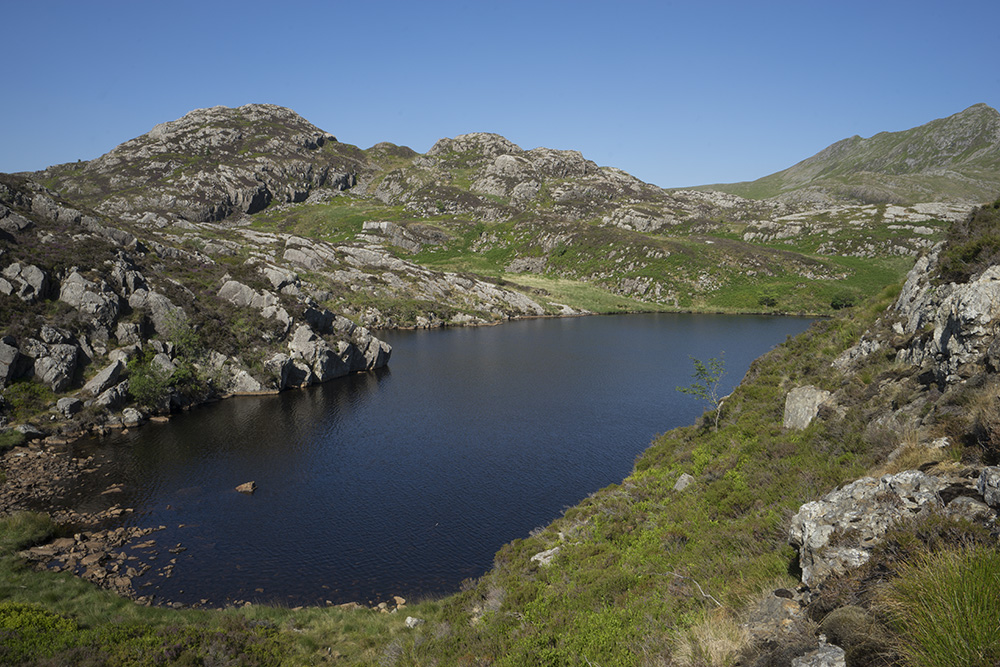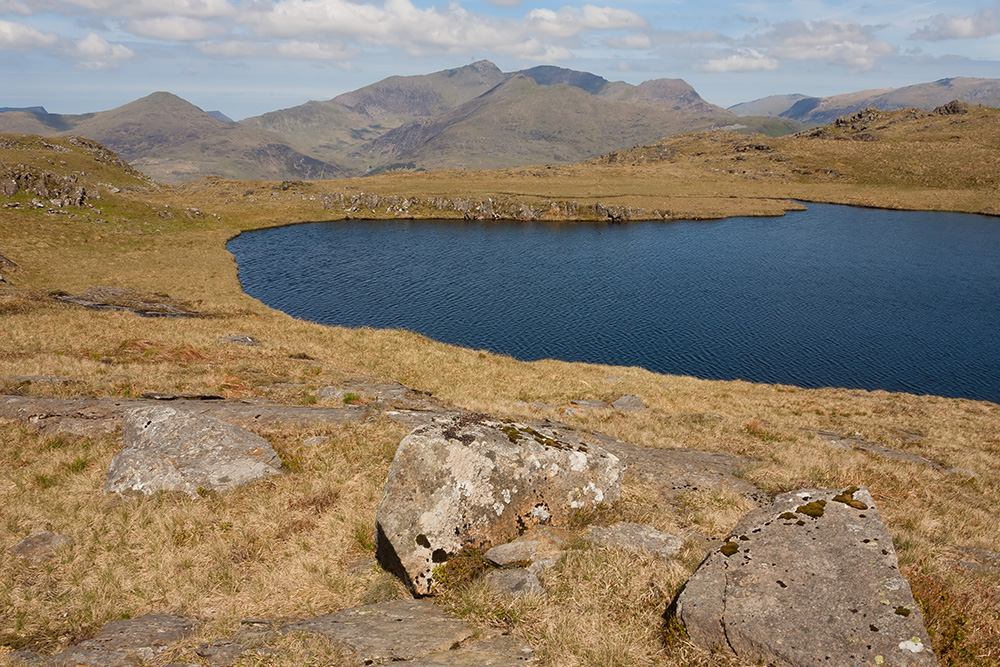What we may well believe has the power to cut and shape and hollow out the dark form of the world surely if wind can, if rain can. But which cannot be held never be held and is no flower
– Cormac McCarthy
There’s rosemary, that’s for remembrance.
Pray, love, remember. And there is pansies,
that’s for thoughts
– William Shakespeare
I had a few days in Snowdonia which weren’t entirely idyllic. The plan was, repeat a walk and camp beside a lake which I did a few years ago. The paths aren’t on a map but I thought would be easy to find. That was partly correct but meant rough wandering and vertical rocks. A foot caught, and I crashed down with the weight of my rucksack. There was no damage but I could have broken a finger, twisted an ankle, or seriously injured my back.
Apart from the difficulties, it was a combination of pleasures. Walking at the sea end of the Moelwyn hills, and staying there like it’s a camp site. That means reading, writing, watching birds, and enjoying the sun. I like camp sites. I luxuriate with a large tent, decent food, chair, coffee, and books. I often walk after lunch, sometimes a substantial route, if the evenings are light.
The first night in Snowdonia was extremely windy so my tent was flattening. I spent a long time finding rocks to weigh down the pegs and guy lines. I slept a little but it was like a meditation on wind: it won’t stop, I’m watching it, it won’t stop, I’m listening to it, it won’t stop, and I hope it doesn’t rain. In Middle Irish poetry there are wind colours, decoding the universe with spatial knowledge:
From the East, the smiling purple,
from the South, the pure white, wondrous,
from the North, the black blustering moaning wind,
from the West, the babbling dun breeze…
Rightly ordered their form,
their disposition was ordained;
with wise adjustments, openly,
according to their position and their fixed places (Saltair na Rann)
What did they mean saying the wind has colours? I’m not sure, but I like the symbolism.
I enjoyed the area, below Cnicht, and understand it better as a result of wild wandering. On the first day, I missed the path and asked advice. They had an idyllic home in a valley with sunshine, trees, children, a small holding and cable internet installed in the pandemic so they could home educate. The tall woman brought me a pint of water. “Is that enough” she said or do you want a bottle. The man brought a map and we studied it. Turn left, then right; right at stepping stones up to the hawthorns.
I’ve done it before I said, a path up that hillside leading to a lake; but now I can’t see where it starts because I’ve arrived differently. He directed me to another path and a different lake which became a problem. It’s that kind of area. Complicated on a small scale, which means you won’t go drastically wrong in good visibility but might have an unpleasant time in heather and bilberry, on rough rocks, and through tick infested ferns.
The photograph above is the lake I had in mind. I found it, randomly, the next day. It was silent except for gliding dragonflies. The photograph below is Llyn yr Adar towards Snowdon. Same area, not from these walks; where I’ve also camped several times.
It was a joy being in Snowdonia, and I like the Moelwyn lakes. I prefer Wales to the Lake District which has the problem of commerce and crowds. You drive congested roads, through busy villages, with souvenir shops, with difficult and chargeable parking. In Beddgelert parking is quite easy. There’s no charge, and the same applies in valleys.
Waking the first morning, the wind had stopped and the skies were blue. I didn’t bother with breakfast and wandered the hills. In one direction there’s Snowdon and Yr Aran. The former I won’t visit again. I’ve seen the cafe and train more than enough. My last walk was from Rhyd Ddu, and I’ve climbed Crib Goch and down the other side perhaps five times. The first hill walk I ever experienced was up Snowdon along the Pyg Track for a school trip. I remember stiff borrowed boots, a wet, flapping, sweaty cagoule, grey rain and discomfort.
The other direction, in the Moelwyn hills, there are views of the sea. Portmeirion is nearby where The Prisoner was filmed. I thought of the line “I am not a number” and tried to remember the reply. I’m not sure but it’s something like “of course you’re not Six” followed by laughter.
The hills are a retreat from society but then there’s home. Can they blend together in writing so they’re not separate? I like patterns. Associative, intuitive, not linear thinking. I like jazz, after a walk, and decided on Keith Jarrett. He’s known for improvised concerts, famously at Koln, but there were others. He composed as he performed: beauty within wildness.
“The quality that we call beauty must always grow from the realities of life” said Junichiro Tanizaki (In Praise of Shadows). It’s an over used term, but walking and camping are grounding experiences. Sky above, earth below, are facts of existence which aren’t so immediate in the city.
I followed sheep tracks through bilberries and remembered the Pyrenees. One morning, after I’d missed Aneto, I set off along a path finding them for breakfast. The glacier approach was unstable and dangerous, and I didn’t have crampons. Aneto is highest, but not the most beautiful Pyrenees mountain. There was early heather in the Moelwyn hills. I thought about the Peak District, which outside of Scotland is perhaps the best place for it. Wild flowers have place. That might be peat, acid, shade, wet, or dry. We too thrive in some places not others.
After Snowdonia, I was looking forward to a local wild field. Last year there was a wonderful display of meadowsweet because of nutrient carrying water. There were floods, and you couldn’t walk there for a week; this year will also be beautiful. There’s a passage in Shakespeare’s Hamlet when Ophelia refers to plants. She’s distressed, and it’s a sad moment, but evokes healing and the Doctrine of Signatures. She describes rosemary and pansies correlating with memory and thought.
I didn’t heat my winter bedroom because of futility and cost. It was minus ten outside, ice on the glass, no different inside. Like camping, I thought, uncomfortable but protected under cover. With a pile of three duvets, three sleeping bags, thick socks and a hat. It was a bad experience leaving a body-mind trace. I thought of Dostoevsky, people crushed by circumstances and cold; the spirit of Russian literature.
I didn’t trust the return of spring. There wasn’t much of it in March and April, although it wasn’t frozen. I did enjoy snake head fritillary, ragged robin, was sad seeing them fade because they broke the spell. Flowers are of time and place. Shady woodland and marshy, spring which becomes summer and meadowsweet. Queen of the Meadow, not sculptural like the tulip or scented like the rose but celebratory, summer-frothy, delicate-almond wild.
Click for short films I made in this area
I write like this is a magazine column. With research, references, and a lot of time. If you like it, perhaps you would support me.


